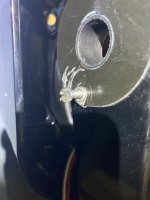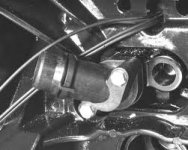Update: I finally got the drive off and discovered why the engine was overheating.
The water inlet hose thru the sterndrive had a sizable crack right before it enters the transom, which reduced the amount of water flow thru the tube and thus starved the the engine of the water it needed to stay cooled.
Now that I've figured that out, I ran into another issue. One of the small screws that holds the trim sender on the gimbal ring is completely stuck. I've tried the following things to get it out, and none of them worked:
1. Tape trick
2. Rubber band trick
3. Penetrating oil
4. Impact driver
5. Using pliers to grab the head and rotate
6. Cut a slot thru the head with a dremel to get a flathead in there
The head of those tiny screws is EXTREMELY malleable, the metal is very weak and bends easily with just a regular screwdriver in it.
I'm not sure what to do next, I guess my other options are 1) try a screw removal/drill set, but I dont think they fit screws this small; or 2) take out the gimbal ring and completely replace it with a new one, which I'm sure is very cheap (/sarcasm)
Another thing I guess I need to do is replace the gear lube hose that runs from the transom thru the gimbal ring to the bell housing. All of the youtube videos said to just cut it, which seems absurd to me that you hsould have to destroy something just to get the bell housing off, but I did it so I need to fix that as well.
And finally, the trials of going thru all this made me realize what a poor design it is to use a thin malleable hose to run water all the way from the lower unit of the sterndrive thru the transom buried under a bunch of other machinery, and finally to the impeller housing.
I'm seriously thinking about putting in a thru hull water inlet hose that runs directly to the impeller. That way it's a very easy fix if there's some kind of blockage or leak that doesn't require me to spend hours to figure out where the issue is.
I know some people create a T joint that brings in the water from the sterndrive and a second hose that runs to the thru hull, but I'd rather just abandon the sterndrive water pickup and put one big hose with a seacock valse and sea water strainer. I figure I can greatly increase the flow of water that way instead of using Mercruiser's small flimsy collapsible rubber hoses that they use in the sterndrive.























